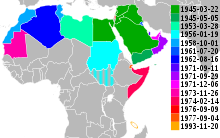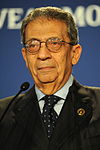Arab League
The Arab League is an organization made up of countries in the Arab world in Northern Africa and Southwest Asia. Most, though not all of these countries use Arabic as their official language. The purpose is to find ways for the countries to have unity and to work together to solve their problems.
League of Arab States
| |
|---|---|
 | |
| Administrative center | Cairoa |
| Official languages | |
| Membership | |
| Leaders | |
| Ahmed Aboul Gheit | |
• Arab Parliament | Ali Al-Daqbaashi |
• Council Presidency | |
| Legislature | Arab Parliament |
| Establishment | |
• Alexandria Protocol | 22 March 1945 |
| Area | |
• Total area | 13,333,296 km2 (5,148,014 sq mi) |
| Population | |
• 2012 estimate | 400,652,486 |
• Density | 24.33/km2 (63.0/sq mi) |
| GDP (PPP) | 2011 estimate |
• Total | $4.766 trillion[1] |
• Per capita | $11895 |
| GDP (nominal) | 2011 estimate |
• Total | [source?] |
• Per capita | [source?] |
| Currency | 21 currencies
|
| Time zone | UTC+0 to +4 |
Website www | |
Background (1900 - 1945)
The Arab League, a regional organisation, finds its roots in two distinctive influences: Arab nationalism (or Arab nationalist movement), and British government support.[2]
Arab Nationalism and Colonialism
The Arab Nationalism represent both a movement that seek the unity of Arab territories in the Arab wolrd and express a rejection of the Ottoman Empire domination. This domination limited the sovereignty of these countries in the region. However, in the beginning of the twentieth century, the control of the Ottoman Empire was facing the rising power control of colonial powers.[3] Both France and Great Britain, by the Skyes-Picot agreement, enforced their domination over each of their mandates (Syra and Lebanon for France, Iraq and Palestine for Great Britain). This partition prevented the evolution of Arab nationalist movement by dismantling the region and creating tensions between the countries.[2]
In the second half of the 1930s, two groups emerged around the question of Arab unification. The 'maximalists' (Syria, Iraq, Transjordan) saw a link between unity and "nation" as way to erase the legacies of colonialism. In opposition, the 'minimalists' (Saudi Arabia, Yemen, and Lebanon) expressed a strong rejection for unification but rather a regional association that will push toward political, cultural, and economic cooperation without impact on their state sovereignty.[3] In reaction, pan-Arab conferences emerged regarding regional issues such as the Palestine situation.
Decolonisation and Unification
Before Wolrd War II, Great Britain supported regional actions initiated by Syrian, Lebanese and Iraqi leaders. This support appeared to undermine French influence on its own mandate.[4]
In 1943, Nuri al-Said, former Prime Minister of Iraq under the British mandate, called for an union between Syria, Lebanon, Jordan and Palestine. This union called Arab League would be, for Nuri al-Said, a permanent council with members in charge of defense, communication, education, and the protection of minorities in the region. The Arab League appears then as a general agreement motivated by Arab nationalist movement.[4] A need for collective action to solve problems in the region emerged even more.
In Egypt, from July 1943 to February 1944, discussions on a programme for an 'Arab Union' between the prime minister Mostafa el-Nahhas and representatives of Arab countries take place. In July 1944, the Egyptian Prime Minister calls the Arab countries' delegates to join a conference regarding the consolidation of this project. This conference takes place in Alexandria on September 25,1944 with the Preparatory Comittee and discusses the organisation and the question of state sovereignty in the union. However, this discussion is unstable due to the different positions of the countries: Syria is in favor, Lebanon and Yemen calls for a different form of cooperation. Regarding this, Egypt shows a model that conciliate both side by confirming the maintain of state sovereignty. This model is supported by Saudi Arabia and nuanced by Iraq that express the need of a voluntary arbitration between the members. This conference end in October 7, 1944 by the denomination Alexandria Protocol. This protocol declared the agreement for the establishment of the Arab League, in the spirit of Arab nationalism. From February 14 to March 3,1945, a commitee prepared the draft for the Pact of Arab League. In a second session, the commitee revised and approved the draft. By March 22, 1945, the commitee in the General Arab Conference signed the pact, which confirmed the creation of the Arab League.[5]
Mission
The organization uses the Arabic Language in its summits and all official papers, although it has never been stated by the League that Arabic is the Official Language. The Arab League was founded following the Protocol of Alexandria signed in 1945 by seven Arab States: Egypt, Lebanon, Saudi Arabia, Syria, Iraq, Yemen, Trans-Jordan (Jordan). Today the League has 22 members. All countries having Arabic as an official language are among the members of the League, except for Israel, Eritrea and Chad which are not members.
Organisation
An international treaty called "the Pact of the League of Arab Sates" organise the Arab League. This treaty is commonly called "the Pact". It has been signed by the first seven members in 1945.
Members
The countries in the Arab League are:
- Egypt - March 22, 1945 (Founder) (suspended, 1979-1989)
- Iraq - March 22, 1945 (Founder)
- Jordan - March 22, 1945 (Founder) (entered when still using the name "Transjordan")
- Lebanon - March 22, 1945 (Founder)
- Saudi Arabia - March 22, 1945 (Founder)
- Syria - March 22, 1945 (Founder)
- Yemen - May 5, 1945 (Founder)
- Libya - March 28, 1953
- Sudan - January 19, 1956
- Morocco - October 1, 1958
- Tunisia - October 1, 1958
- Kuwait - July 20, 1961
- Algeria - August 16, 1962
- United Arab Emirates - June 12, 1971
- Bahrain - September 11, 1971
- Qatar - September 11, 1971
- Oman - September 29, 1971
- Mauritania - November 26, 1973
- Somalia - February 14, 1974
- Palestine - succeeding to the position held by the Palestine Liberation Organization since September 9, 1976
- Djibouti - April 9, 1977
- Comoros - November 20, 1993

The Council
The Arab League main organ is the Council (article 3 of the Pact). Each state member of the organisation has a representative in the Council with one vote (article 3 of the Pact). When the Council vote on a subject, the members of the League do not have to apply the decision if they voted against it (article 7 of the Pact). The members of the Council meet ordinary twice a year in March and in September (article 11 of the Pact). The president of the Council is one of the state. It changes every ordinary meeting.[6]
The Secretary-General
The Council chooses a Secretary-General with a two-third vote.[6] The Secretary-General is responsible for the administrative organisation of the meetings. Also, when the Council votes a resolution, the Secretary-General makes sure the decisions are followed by member states.[7]
List of Secretaries-General
| Secretary-General | Birth–Death | Took office | Left office | Nationality | Photo | |
|---|---|---|---|---|---|---|
| 1 | Abdul Rahman Azzam | 1893–1976 | 22 March 1945 | September 1952 |  Egypt Egypt | |
| 2 | Abdul Khalek Hassouna | 1898–1992 | September 1952 | 1 June 1972 |  Egypt Egypt | |
| 3 | Mahmoud Riad | 1917–1992 | 1 June 1972 | March 1979 |  Egypt Egypt |  |
| 4 | Chedli Klibi | 1925–2020 | March 1979 | September 1990 |  Tunisia Tunisia |  |
| 5 | Ahmed Asmat Abdel-Meguid | 1924–2013 | 15 May 1991 | 15 May 2001 |  Egypt Egypt |  |
| 6 | Amr Moussa | 1936–present | 15 May 2001 | 1 July 2011 |  Egypt Egypt |  |
| 7 | Nabil Elaraby | 1935–present | 1 July 2011 | 3 July 2016 |  Egypt Egypt |  |
| 8 | Ahmed Aboul Gheit | 1942–present | 3 July 2016 | ' |  Egypt Egypt |  |
The Joint Defense Council
Ministers of Defense and Ministers of Foreign Affairs from the member states compose the Joint Defense Council.[8]
Positions on conflicts
Conflicts between countries of the Arab League
The members of the Arab League agree not to resolve their conflicts with force (article 3 of the Pact). If there is a conflict between two members of the Arab League, they can call for a resolution of the Council. In that case, the resolution is binding to both countries.[6]
Israeli-Palestinian conflict
The Arab League is politically involved in the Israeli-Palestinian conflict. Even before the creation of the League, Arab countries, particularly Saudi Arabia and Iraq had discussions on lobbying in Washington, D.C. and in London to fight zionism. Saudi Arabia even declared: the "danger of Zionism is one that threatens the interests of all Arabs and Moslems."[9]
During the Alexandria conference in 1944, the founders of the Arab League chose Musa Alami to represent the Palestinian Arabs in the conference. In the Pact, the member states declare they support to the "Arabs of Palestine" against Israel.
During a summit in Lebanon in October 1947, the League decided that Arab nations would protect Palestinian territory with their regular armies. However, the member states were not able to agree on how they would implement this decision.[10]
In the 1964 summit in Cairo, the League promoted the creation of a Palestinian entity. It led to the creation of the Palestinian Liberation Organization.
After the 1967 summit in Khartoum, the League issued a declaration called the Khartoum Resolution. It is famous for the "three noes" policy described in article 3 of the declaration.
"(...) the framework of the main principles by which the Arab States abide, namely, no peace with Israel, no recognition of Israel, no negotiations with it, (...)"[11]

